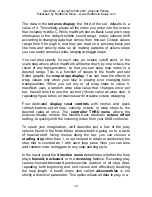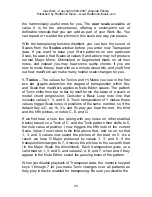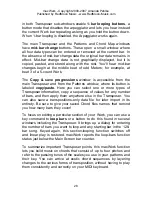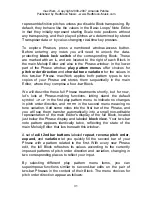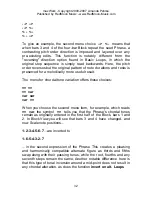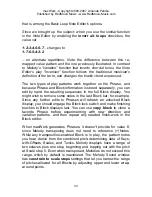
maxWerk - Copyright 2000-2007 Amanda Pehlke
Published by RedMoon Music - www.RedMoon-Music.com
19
forward direction, but applies a note-scrambling function that causes
a fresh shuffle of existing step values at each new loop-start, while
leaving unchanged the pattern of durations that gives the loop its
rhythmic feel. The next play direction is random, followed by ends-
inward and two variations of this pattern, alt ends-in and rdm
ends-in. These play the first step, then the last, the second, the
next-to-last, and so on, working toward the middle of the displayed
pattern. The 'alt' variation begins with normal forward play, makes
an ends-inward pass, plays normally again, and on the next ends-
inward pass begins at the middle. Randomized ends-inward
behavior mixes with normal play for the final menu option.
With the play mode menu set to its default first item play changes,
a note sounds until another of a different value replaces it, or until it
is given a companion velocity of 0. Each changed note triggers a
note-off of the last, and uses by default the velocity, octave, and
wrap data at the same step number. A note value of 0 turns the last
note off, whatever the velocity at that time.
When you choose the second item play all steps, maxWerk
triggers a new note at each non-zero step in a robotic manner after
the manner of older analog hardware step sequencers, regardless
of the changing state of note values or step resolution.
The third menu item is sustain note-groups. This mode tells
maxWerk to trigger and sustain all added pitches until the next note
(not velocity!) value of 0 in the Editor, or until the end of the loop,
whichever occurs first. The only velocity values that make a
difference are those that begin notes; in sustain mode maxWerk
ignores velocity values of 0. You can make a multi-note pad hold
and move with transpositions for up to four bars, for if there is no
note value of 0 in the loop, with the transposing function enabled
only changes in pitch cause the notes to cut off and re-trigger.
When you try out this mode, the color-changing gate time slider
alongside the mode menu automatically resets to its default value 0.
Leave it there or at its full right position while you investigate play
modes. In modes other than sustain, you can store a setting shorter
than a full step, albeit with coarse resolution when step resolution is
high. Read about gating possibilities under "Loop Magic 1" in Part II.














